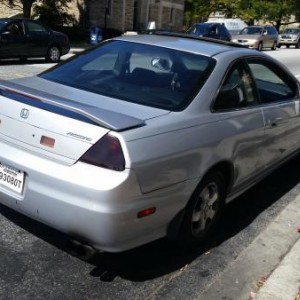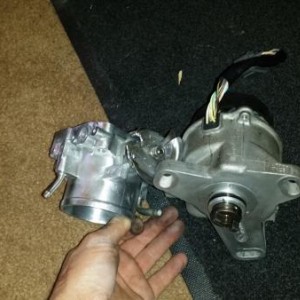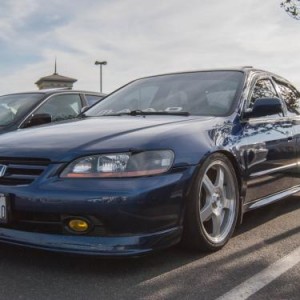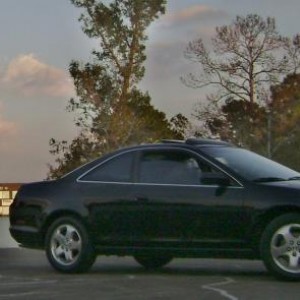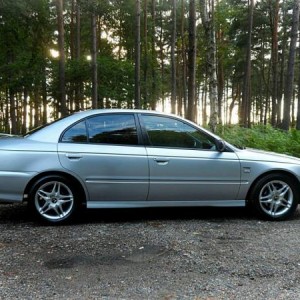AFAccord
Well-Known Member
Well, I've posted this on H-T, but many people here are allergic to the attitudes of H-T members (now you know where I get it from), so I'll post it here as well...
So the time has come to get retune the Accord with a few new mods, including my new Bisimoto Level 2 Camshaft. I have already installed the cam and checked for clearance issues that I was concerned about, but everything looks good now.
I would normally be fine with just a street tune to touch everything up because it's much cheaper than dyno time, but the uprising against Bisi's credibility has me motivated to get some actual numbers up for comparison. My tuner J. Davis, is working on getting some cheap dyno time scheduled for me. I'm confident he can bring out the best of this all-motor setup, despite the fact that he's much more partial to high-boost setups.
Without any more rambling, here's the setup for testing:
2000 Accord EX Coupe
* F23A1 Engine, stock bottom end with ~62k miles
* Mild port work on the head
* Milled head (.030", calculates to ~9.9-10.0cr)
* Bisimoto Level 2 Cam
* Bisimoto Pro Valve Springs
* Bisimoto Pro Retainers
* Cam Gear with grade 8 bolts
* H23 Intake Manifold with Adapter Plate
* P61 ECU (92-93 GSR) chipped and tuned with eCtune
* CAI (hacked up)
* eBay 4-2-1 header with 2.5" collector mod
* 2.5" Mandrel bent exhaust
* Vibrant Flat Black muffler
* Vibrant Ultra Quiet Resonator
* 12lb Lightened OE Flywheel
* LSD Motorsports 6-puckClutch
* Custom geared M2S4 5-speed transmission
* Energy Suspension Poly motor mount inserts
* ARP Head studs
* Bisimoto Licence plate frame!
That's all I can think of right now. The car has made from 169whp to 186whp depending on the dyno, location and weather conditions, which is why I plan to reinstall the stock camshaft and dyno a baseline run before swapping in the Bisi cam and tuning that. I'll post up details and a date as soon as I know something.
So the time has come to get retune the Accord with a few new mods, including my new Bisimoto Level 2 Camshaft. I have already installed the cam and checked for clearance issues that I was concerned about, but everything looks good now.
I would normally be fine with just a street tune to touch everything up because it's much cheaper than dyno time, but the uprising against Bisi's credibility has me motivated to get some actual numbers up for comparison. My tuner J. Davis, is working on getting some cheap dyno time scheduled for me. I'm confident he can bring out the best of this all-motor setup, despite the fact that he's much more partial to high-boost setups.
Without any more rambling, here's the setup for testing:
2000 Accord EX Coupe
* F23A1 Engine, stock bottom end with ~62k miles
* Mild port work on the head
* Milled head (.030", calculates to ~9.9-10.0cr)
* Bisimoto Level 2 Cam
* Bisimoto Pro Valve Springs
* Bisimoto Pro Retainers
* Cam Gear with grade 8 bolts
* H23 Intake Manifold with Adapter Plate
* P61 ECU (92-93 GSR) chipped and tuned with eCtune
* CAI (hacked up)
* eBay 4-2-1 header with 2.5" collector mod
* 2.5" Mandrel bent exhaust
* Vibrant Flat Black muffler
* Vibrant Ultra Quiet Resonator
* 12lb Lightened OE Flywheel
* LSD Motorsports 6-puckClutch
* Custom geared M2S4 5-speed transmission
* Energy Suspension Poly motor mount inserts
* ARP Head studs
* Bisimoto Licence plate frame!
That's all I can think of right now. The car has made from 169whp to 186whp depending on the dyno, location and weather conditions, which is why I plan to reinstall the stock camshaft and dyno a baseline run before swapping in the Bisi cam and tuning that. I'll post up details and a date as soon as I know something.
Last edited:




